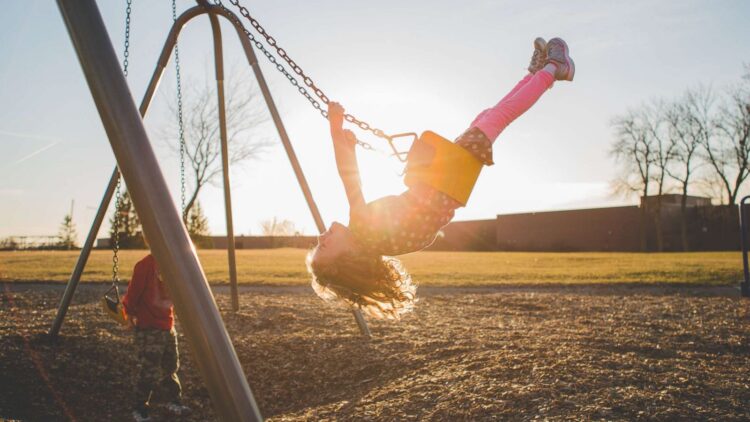There’s an anxiety epidemic impacting young people throughout the United States. Young adults claim to not know how to “adult.” New parents often feel completely clueless about how to raise competent, confident kids. These issues and more can often be attributed to the “helicopter parenting” age.
Beginning in the 1980s and proliferating throughout the following decades, helicopter parents hovered and rescued whenever trouble arose. While their intentions may have been good, too much of a good thing can stunt a child’s development.
Children thrive and grow when allowed to test boundaries in a safe environment. Many parents are shifting to a “free-range” approach, which helps kids build lifelong skills and confidence.
1. Encourage Independent Play

A primary goal of free-range parenting is to develop confidence among children. Part of this is supported by providing opportunities for kids to make decisions for themselves. While you may not give your kid-free rein over their meal choices, you can give them ownership of their play.
Depending on their age, this may entail allowing more distance between you and your kids on a playground. For older kids, it may mean encouraging them to explore a nearby park. Practice giving your child more responsibility over time, and add boundaries where they make sense for your family. For more ideas on safely expanding your child’s boundaries, visit this site.
2. Let Go of Over-Programming
Soccer league, dance class, and coding camp fliers have been overflowing from your kid’s backpack of late. While helping your child learn new skills is great, stacking their day with programs can do more harm than good. Kids only get so long to be kids, so be mindful of how busy you keep them. And if they complain of boredom, that may not be a bad thing.
Some of the best creative thought comes from moments of boredom when our minds try to self-stimulate. If your kids are so busy running from one thing to the next, you could inadvertently stunt their creative thinking. Instead, trim down formal programming to the one activity your kid is most interested in. That way, you’ll leave plenty of space for both creativity and just being a kid.
3. Make Nature Their Playground

Technology, on the whole, has improved our lives as humans. But it can be detrimental to a child’s development if it’s overused. That’s why those who practice free-range parenting encourage their kids to immerse themselves in nature instead of getting sucked in by a screen.
Allow your kids to play freely outdoors in areas you’ve vetted for safety. Your fenced backyard is a great place to start, giving your kid a chance to be both independent and with nature. The next time they ask for something to do, make the outdoors their play space. Encourage them to play with their siblings or pets to add to the fun.
If they need encouragement, point out new things happening outside, like flowers blooming, leaves turning colors, or animals visiting. Spark their creativity by asking what-if questions like, “What if you decided to sleep outside?” This simple question could have them building a tent with sticks, leaves, and outdoor cushions.
4. Allow Them to Test Limits in Small Doses
Free-range parenting isn’t about releasing your child into the wild. It’s a lifestyle built on mutual trust and understanding. Start small, and once your child has been successful with what you’ve tried, give them more independence. If it’s too much too soon, remember that you can always pull back if needed. This style of parenting is an exercise in learning and patience, and being mindful of your child’s progress is paramount.
The next time you take your kid on a walk, let them head out before you. Establish a distance where they’re permitted to go ahead, like the next driveway or the next block, and see how they do. Allowing them to skip freely instead of holding your hand tightly can incite confidence and pure joy in your child.
When you’re in the grocery store, allow them to practice scanning items in the self-checkout lane. Giving them autonomy helps them learn skills that they can apply in every area of their lives.
5. Plan for Safe Play

There are a lot of dangers in the world, but it’s unlikely that even the most intense worry will eliminate them. What you can do is be aware and make plans on how to manage risk for both you and your child.
Examine your home setting, neighborhood, and general stomping grounds and consider the risk factors you need to address. If you have a swimming pool, make sure you have a safety cover or fence around it. For families that live on busy streets, consider a fence in the front yard with a locking gate.
Review expectations for your child on what play areas they can go to and what activities they can engage in. If they want to ride their bike, make sure they can access it and put on their helmet. Kids with playsets should know that they’re free to play as they wish, but teach them safe practices. Help them calculate the risks of jumping from their climbing wall so they understand the possible outcomes of their choices. You can’t prevent every injury or accident, but you can help lay the foundation for safe play.
Developing a Plan that Suits Your Family
The idea of free-range parenting may be contradictory to your current approach. Identify free-range principles that you can introduce to your child over time. Once you both are confident with the first change, such as playing independently at the local playground, take another step.
With each new skill mastered, your child will build confidence and trust in themselves that can only be learned by doing. Over time, they’ll apply what they’ve learned in every new stage of life, setting themselves up for success. As adults, they’ll be confident as they take on new challenges, prepared to tackle the unknown. Their success and self-sufficiency will be achieved thanks to the fact that you placed your trust in them, starting at a young age.
 Hi Boox Popular Magazine 2024
Hi Boox Popular Magazine 2024



